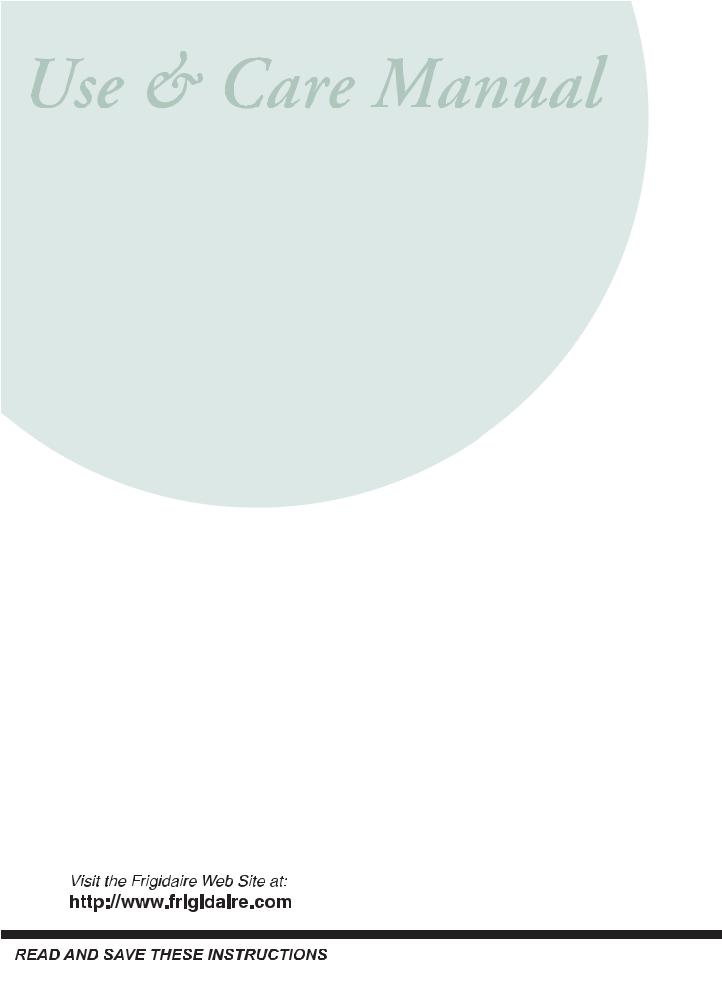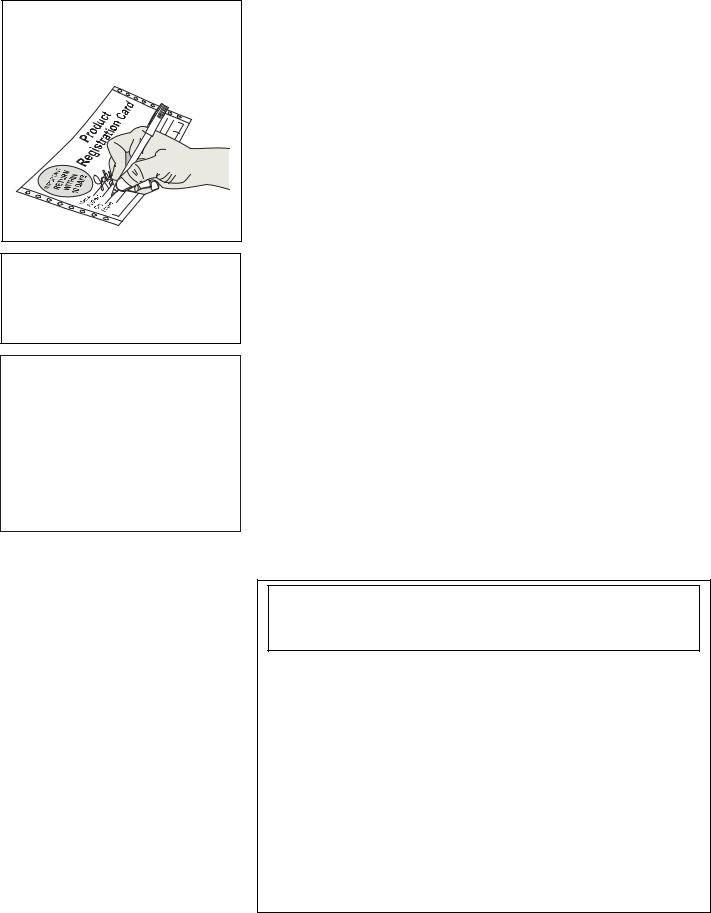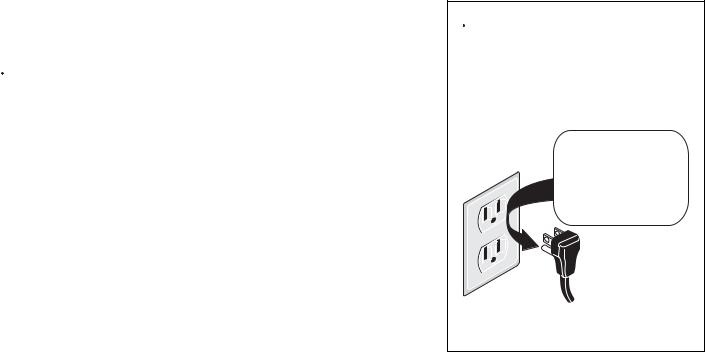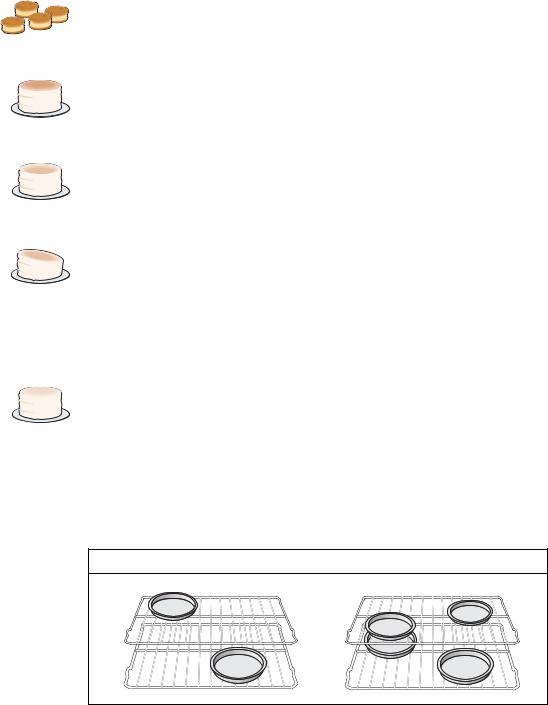Frigidaire FGB24L2AB, FGB24S5AB, FGB24S5AS, FGB24L2AS, FGB24S5DC User Manual

Gas
Wall Oven
CONTENTS |
Page |
|
Versión en español .................................................................... |
2 |
|
Product Registration .................................................................. |
2 |
|
Important Safety Instructions .................................................. |
3-4 |
|
Grounding Instructions .............................................................. |
5 |
|
Oven Ignition ............................................................................. |
5 |
|
Liquefied Petroleum (Propane) Gas Conversion (some models) 5 |
||
Oven Baking ............................................................................... |
6 |
|
Air Circulation in the Oven ......................................................... |
6 |
|
Oven Cleaning ......................................................................... |
7-8 |
|
Setting the Controls for a Clean Cycle ........................................ |
8 |
|
General Cleaning ........................................................................ |
9 |
|
Single Oven Models |
|
|
• Before Setting Oven Controls ........................................... |
10 |
|
• |
Setting Oven Controls ...................................................... |
10 |
• |
Adjusting Oven Temperature ............................................ |
10 |
• |
General Cleaning ......................................................... |
10-11 |
• |
Changing Oven Light ....................................................... |
11 |
Double Oven Models |
|
|
• Setting the Clock and Minute Timer ................................. |
12 |
|
• Before Setting Oven Controls ........................................... |
13 |
|
• |
Setting Oven Controls ...................................................... |
14 |
• |
General Cleaning ......................................................... |
14-15 |
• |
Changing Oven Light ....................................................... |
16 |
• |
Adjusting Oven Temperature ............................................ |
16 |
Avoid Service Checklist ....................................................... |
17-18 |
|
Notes ....................................................................................... |
19 |
|
Warranty .................................................................................. |
20 |
|
318200957 (0703) Rev. A

Product Registration
Register Your Product
The PRODUCT REGISTRATION CARD should be filled in completely, signed and returned to Electrolux Home Products North America.
This Owner's Guide contains general operating instructions for your appliance and feature information for several models. Your appliance may not have all the described features.
Thank you for choosing this appliance. The information contained within this
Owner's Guide will instruct you on how to properly operate and care for your wall oven. Please read through the information contained in your literature pack to learn more about your new appliance.
Record Your Model and Serial Numbers
Record in the space provided below the model and serial numbers found on the serial plate located on the lower left hand inner trim of the oven or on the side of the lower oven frame (models with two ovens).
Model Number: ____________________________________________________
Serial Number: _____________________________________________________
Date Purchased: ____________________________________________________
Note: The instructions appearing in this Owner's Guide are not meant to cover every possible condition and situation that may occur. Common sense and caution must be practiced when installing, operating and maintaining any appliance.
Versión en español
Si desea obtener una copia en español de este Manual del Usuario, sírvase escribir a la dirección que se incluye a continuación. Solicite la P/N 318204012.
Electrolux Home Products
Attn : Care Use
P.O. Box 212378
Augusta, GA 30917
© 2007 Electrolux Canada Corp. All rights reserved




 If the information in this manual is not followed exactly, a fire or explosion may result causing property damage, personal injury or death.
If the information in this manual is not followed exactly, a fire or explosion may result causing property damage, personal injury or death.
FOR YOUR SAFETY:
—Do not store or use gasoline or other flammable vapors and liquids in the vicinity of this or any other appliance.
—WHAT TO DO IF YOU SMELL GAS:
•Do not try to light any appliance.
•Do not touch any electrical switch; do not use any phone in your building.
•Immediately call your gas supplier from a neighbor's phone. Follow the gas supplier's instructions.
•If you cannot reach your gas supplier, call the fire depart-
ment.
—Installation and service must be performed by a qualified installer, servicer or the gas supplier.
2

IMPORTANT SAFETY INSTRUCTIONS
Read all instructions before using this appliance.
Save these instructions for future reference.
This guide contains important safety symbols and instructions. Please pay special attention to these symbols and follow all instructions given. Here is a brief explanation of these symbols.
This symbol will help alert you to situations that may cause serious bodily harm, death or property damage.
This symbol will help alert you to situations that may cause bodily injury or property damage.
•Remove all tape and packaging wrap before using the appliance. Destroy the carton and plastic bags after unpacking the appliance. Never allow children to play with packaging material. Do not remove the wiring label and other literature attached to the back of the appliance. Do not remove model/serial number plate.
•Proper Installation—Be sure your appliance is properly installed and grounded by a qualified electrician or installer in accordance with the National Electrical Code ANSI/NFPA No. 70 (U.S.A.) or CSA C22.1, PART 1 (Canada)—latest editions and local code requirements.
Install only per installation instructions provided in the literature package for this appliance.
Ask your dealer to recommend a qualified installer, technician or an authorized repair service. Know how to disconnect the electrical power to the appliance at the circuit breaker or fuse box in case of an emergency.
 Electronic controllers can be damaged by cold temperatures. When you use your appliance for the first time, or if it has been used for a long period of time, make sure that it has been exposed to a temperature above 0°C/32°F for at least 3 hours before connecting it to the power supply.
Electronic controllers can be damaged by cold temperatures. When you use your appliance for the first time, or if it has been used for a long period of time, make sure that it has been exposed to a temperature above 0°C/32°F for at least 3 hours before connecting it to the power supply.
•User Servicing—Do not repair or replace any part of the appliance unless specifically recommended in the manuals. All other servicing should be done only by a qualified technician. This may reduce the risk of personal injury and damage to the appliance.
•Never modify or alter the construction of the appliance by removing panels, wire covers, or any other part of the product.
•Remove the oven door from any unused wall oven if it is to be stored or discarded.




 Stepping, leaning or sitting on the door(s) or drawer of this appliance can result in serious injuries and may also cause damage to the appliance. Do not allow children to climb or play around the appliance.
Stepping, leaning or sitting on the door(s) or drawer of this appliance can result in serious injuries and may also cause damage to the appliance. Do not allow children to climb or play around the appliance.
•Storage in or on Appliance—Flammable materials should not be stored in an oven, or in the broiler drawer (if equipped). This includes paper, plastic and cloth items,
such as cookbooks, plasticware and towels, as well as flammable liquids. Do not store explosives, such as aerosol cans, in or near the appliance.




 Do not use the wall oven for storage.
Do not use the wall oven for storage.
 Do not store items of interest to children in the cabinets above an appliance. Children climbing on the appliance to reach items could be seriously injured.
Do not store items of interest to children in the cabinets above an appliance. Children climbing on the appliance to reach items could be seriously injured.
•Do not leave children alone—Children should not be left alone or unattended in the area where an appliance is in use. They should never be allowed to sit or stand on any part of the appliance.
•DO NOT TOUCH INTERIOR OVEN BURNER OR INTERIOR SURFACES OF THE WALL OVEN UNTIL THEY HAVE COOLED. The oven heating burner may be hot even though the flames are not visible. Areas near the burner may become hot enough to cause burns. During and after use, do not touch, or let clothing or other flammable materials touch these areas until they have had sufficient time to cool. Among these areas are the oven vent openings, the surfaces near these openings, oven door, window and broiler drawer.
•Wear Proper Apparel—Loose-fitting or hanging garments should never be worn while using the appliance. Do not let clothing or other flammable materials contact hot surfaces.




 NEVER use this appliance as a space heater to heat or warm the room. Doing so may result in carbon monoxide poisoning and overheating of the oven.
NEVER use this appliance as a space heater to heat or warm the room. Doing so may result in carbon monoxide poisoning and overheating of the oven.
•Do Not Use Water or Flour on Grease Fires—Smother the fire with a pan lid, or use baking soda, a dry chemical or foam-type extinguisher.
•When heating fat or grease, watch it closely. Fat or grease may catch fire if allowed to become too hot.
•Use Only Dry Potholders—Moist or damp potholders on hot surfaces may result in burns from steam. Do not let the potholders touch the flame or burners. Do not use a towel or other bulky cloth instead of a potholder.
3

IMPORTANT SAFETY INSTRUCTIONS (continued)
•Do Not Heat Unopened Food Containers—Build-up of pressure may cause the container to burst and result in injury.
•Remove the oven doors from any unused appliance if it is to be stored or discarded.
•IMPORTANT—Do not attempt to operate the oven during a power failure. If the power fails, always turn the oven off. If the oven is not turned off and the power resumes, the oven will begin to operate again. Food left unattended could catch fire or spoil.
•Do not use your broiler pan without its insert. The broiler pan and grid allow dripping fat to drain and be kept away from the high heat of the broiler.
•Do not cover your broiler grid or oven bottom with aluminum foil. Exposed fat and grease could ignite.
•Do not touch a hot oven light bulb with a damp cloth.
Doing so could cause the bulb to break. Disconnect the oven or shut off the power to the oven before removing and replacing the bulb.
IMPORTANT INSTRUCTIONS FOR
USING YOUR OVEN
•Use Care When Opening an Oven Door—Stand to the side of the appliance when opening the door of a hot oven. Let hot air or steam escape before you remove or replace food in the oven.
•Keep Oven Vent Ducts Unobstructed. The wall oven is vented at the upper control panel trim or grille. Touching the surfaces in this area when the wall oven is operating may cause severe burns. Also, do not place plastic or heat-sensitive items near the oven vent. These items could melt or ignite.




 NEVER cover any slots, holes or passages in the oven bottom or cover an entire rack with materials such as aluminum foil. Doing so blocks air flow through the oven and may cause carbon monoxide poisoning. Aluminum foil linings may trap heat, causing a fire hazard.
NEVER cover any slots, holes or passages in the oven bottom or cover an entire rack with materials such as aluminum foil. Doing so blocks air flow through the oven and may cause carbon monoxide poisoning. Aluminum foil linings may trap heat, causing a fire hazard.
•Placement of Oven Racks. Always place oven racks in desired location while oven is cool. If the rack must be moved while the oven is hot, use extreme caution. Use potholders and grasp the rack with both hands to reposition. Do not let potholders contact the oven burner flame or interior of the oven or broiler drawer. Remove all utensils from the rack before removing the rack.
IMPORTANT INSTRUCTIONS FOR
CLEANING YOUR OVEN
•Clean the wall oven regularly to keep all parts free of grease that could catch fire. Do not allow grease to accumulate.
•Kitchen Cleaners/Aerosols—Always follow the manufacturer's recommended directions for use. Be aware that excess residue from cleaners and aerosols may ignite causing damage and/or injury.
SELF-CLEANING OVENS
•Clean in the self-cleaning cycle only the parts of the oven listed in this owner's guide. Before self-cleaning the oven, remove any utensils stored in the oven.
•Do not clean the oven door gasket. The door gasket is essential for a good seal. Care should be taken not to rub, damage or move the gasket.
•Do not use oven cleaners. No oven cleaner or oven liner protective coating of any kind should be used in or around any part of the oven.
 The health of some birds is extremely sensitive to the fumes given off during the self-clean cycle of any range. Move birds to another wel ventilated room.
The health of some birds is extremely sensitive to the fumes given off during the self-clean cycle of any range. Move birds to another wel ventilated room.
IMPORTANT SAFETY NOTICE
The California Safe Drinking Water and Toxic Enforcement Act requires the Governor of California to publish a list of substances known to the state to cause cancer, birth defects or other reproductive harm, and requires businesses to warn customers of potential exposure to such substances.
SAVE THESE INSTRUCTIONS
4

Grounding Instructions (electric ignjtion models only) IMPORTANT: READ AND SAVE THESE INSTRUCTIONS.




 This appliance is equipped with a 3-prong grounding plug for
This appliance is equipped with a 3-prong grounding plug for
your protection against shock hazard and should be plugged directly into a properly grounded receptacle. DO NOT cut or remove the grounding prong from this plug.
For personal safety, this oven must be properly grounded. For maximum safety, the power cord must be plugged into a 120V—60 Hz. outlet that is correctly polarized and properly grounded.
If a two-prong wall receptacle is the only available outlet, it is the personal responsibility of the consumer to have it replaced with a properly grounded three-prong wall receptacle installed by a qualified electrician.
DO NOT UNDER ANY CIRCUMSTANCES CUT OR REMOVE THE THIRD ROUND GROUNDING PRONG FROM THE POWER CORD PLUG. SEE THE INSTALLATION INSTRUCTIONS PACKAGED WITH THIS OVEN FOR COMPLETE INSTALLATION AND GROUNDING INSTRUCTIONS. DO NOT OPERATE THE OVEN USING A TWO-PRONG ADAPTER OR AN EXTENSION CORD.




 Avoid fire hazard or electrical shock. Do not use an adaptor plug, an extension cord, or remove grounding prong from electrical power cord. Failure to follow this warning can cause serious injury, fire or death.
Avoid fire hazard or electrical shock. Do not use an adaptor plug, an extension cord, or remove grounding prong from electrical power cord. Failure to follow this warning can cause serious injury, fire or death.
Grounding |
|
type wall |
Do not, under any |
receptacle |
circumstances, cut, |
|
remove, or bypass |
|
the grounding prong. |
Power supply cord with 3-prong grounding plug
Oven Ignition
When you turn the oven on, the glow bar igniter begins to heat. When the lighter is hot enough, in less than 1 minute, the gas flows into the burner and is ignited.
The igniter glows bright orange when hot. It cycles on and off with the thermostat and will glow whenever the burner is on.




 Do not attempt to light the oven burners during a power failure. The oven burner valves will not open up and will prevent the gas from flowing through the burner valves to the burners. In the event of a power failure, turn the Temperature Control knob to OFF. When power resumes, turn the Temperature Control knob back to desired temperature.
Do not attempt to light the oven burners during a power failure. The oven burner valves will not open up and will prevent the gas from flowing through the burner valves to the burners. In the event of a power failure, turn the Temperature Control knob to OFF. When power resumes, turn the Temperature Control knob back to desired temperature.
Liquefied Petroleum (Propane) Gas Conversion (some models only)
This appliance can be used with Natural Gas or Liquefied Petroleum (Propane) Gas. It is shipped from the factory for use with Natural Gas.
Refer to the Installation Instructions for conversion from Natural Gas to Propane Gas, or from Propane Gas to Natural Gas. 



 Severe shock or damage to the appliance may occur if the appliance is not installed by a qualified installer.
Severe shock or damage to the appliance may occur if the appliance is not installed by a qualified installer.
5

Oven Baking
"Baking" means to cook foods such as cakes or casseroles by dry heat in a covered or uncovered pan. Roasting, often confused with baking, means to cook meat in an uncovered pan. To Bake or Roast, follow the instructions in the Setting Oven Controls section.
Baking Problems and |
Product Expectations |
|
The cooking times and temperatures needed to bake a product may vary slightly from |
||
Solutions Chart (Below) |
||
your previously owned appliance |
||
|
||
|
Baking Problems |
Causes |
Corrections |
|
|
|
Cookies and |
• Cookies and biscuits put into the |
• Allow oven to preheat to the selected temperature before placing |
biscuits burn on the |
oven before the preheating time (10 |
food in oven. |
bottom. |
minutes approx.) is completed. |
• Choose pan sizes that will permit 2-4" (5-10 cm) of air space on all |
|
• Oven rack overcrowded. |
sides when placed in the oven. |
|
• Dark pan absorbs heat too fast. |
• Use a medium-weight aluminum baking sheet. |
|
|
|
Cakes too dark on top |
• Cakes put into the oven before |
• Allow oven to preheat to the selected temperature before placing |
or bottom. |
preheating time (10 minutes approx.) |
food in the oven. |
|
is completed. |
• Use proper rack position for baking needs. |
|
• Rack position too high or low. |
• Set oven temperature 25°F/12°C lower than recommended. |
|
• Oven too hot. |
|
|
|
|
Cakes not done in the |
• Oven too hot. |
• Set oven temperature 25°F/12°C lower than recommended. |
center. |
• Incorrect pan size. |
• Use pan size suggested in recipe. |
|
• Pan not centered in oven. |
• Use proper rack position and place pan so there is 2-4" (5-10 cm) |
|
|
of space on all sides of pan. |
|
|
|
Cakes not level. |
• Wall oven not level. |
• Place a marked glass measuring cup filled with some water on the |
|
• Pan too close to oven wall or rack |
center of the oven rack. If the water level is uneven, refer to the |
|
overcrowded. |
installation instructions for leveling the range. |
|
• Pan warped. |
• Be sure to allow 2-4" (5-10 cm) of clearance on all sides of each pan |
|
• Oven rack not level. |
in the oven. |
|
|
• Do not use pans that are dented or warped. |
|
|
• Check oven rack for flatness and proper positioning. |
|
|
|
Foods not done when |
• Oven too cool. |
• Set oven temperature 25°F/12°C higher than suggested and bake |
cooking time is up. |
• Oven overcrowded. |
for the recommended time. |
|
• Oven door opened too frequently. |
• Be sure to remove all pans from the oven except the ones to be used |
|
|
for baking. |
|
|
• Open oven door only after shortest recommended baking time. |
|
|
|
Air Circulation in the Oven
For best air circulation and baking results, center pans as much as possible. Allow 2-4" (5-10 cm) around the utensil(s) for proper air circulation and be sure pans do not touch each other, the door, sides or back of oven. The hot air must circulate around the pans in the oven for even heat to reach all parts of the oven.
If using multiple pans, stagger as shown. If using one pan, place in center of oven.
6
